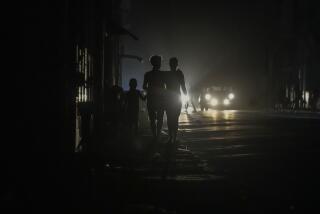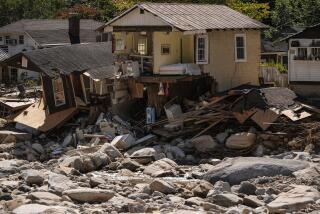Government Blamed for Deaths in Mexico
MEXICO CITY â Even as it rushed more food, water and soldiers into beleaguered Acapulco on Monday, the Mexican government faced a storm of criticism for its lack of preparation before the devastating hurricane that lashed the resort city last week.
Politicians, scientists and newspaper columnists said scores of lives could have been saved if authorities had evacuated hillside slums that were swept away by torrents of rainwater.
âWhen it comes to civil protection, weâre still in diapers,â complained Abraham Zabludovsky, a newscaster for Mexicoâs leading television channel, Televisa, in a striking departure from its usual pro-government line.
âWe hope this will be corrected,â he said on the midday news Monday. âThis always happens after a tragedy--but then tragedies always happen again.â
The catastrophe also highlighted a disastrous lack of regulation in Acapulco, where peasants had chopped down trees and built shantytowns on unstable hillsides. Hurricane Pauline ripped into Mexicoâs Pacific coast Wednesday and Thursday, leaving 193 people dead and hundreds missing, many in Acapulco, according to local officials. The Red Cross estimates 400 died in the states of Guerrero, which includes Acapulco, and Oaxaca.
Authorities have insisted that it was impossible to foresee the fury of Pauline or its consequences in Acapulco. âNo machine, no instrument, could have predicted that the hurricane would have this magnitude,â said Tomas Benitez, a spokesman for the Guerrero state government.
In addition, officials noted, many residents appeared to ignore storm warnings on television and radio.
*
But with frequent bulletins being issued by U.S. and Mexican meteorological stations, it was clear that a major storm was approaching the coast. Authorities acknowledged that there were no appeals to citizens to evacuate, no shelters set up in Acapulco before the storm.
Opposition politicians called Monday for an investigation into the preparations for the hurricane and punishment for those responsible for the many deaths.
But others said the lack of preparation reflected the fact that Mexico is only slowly developing mechanisms to respond to disasters. This country didnât even have a civil protection system until after the devastating Mexico City earthquake of 1985, officials noted.
âWith these storms, itâs not possible to pinpoint exactly where they are going to hit . . . and itâs difficult to evacuate people when it is so difficult to mobilize themâ in a large area, said Jose Barroso, president of the Mexican Red Cross.
The tragedy focused fresh attention on the precariously built shantytowns on the slopes of the mountains surrounding Acapulcoâs famous deep-blue bay. Ivan Restrepo, a Mexico City environmentalist, said the local government had moved peasants off the badly eroded mountainsides in the 1970s.
Twenty years later, they were back.
Although Restrepo and other environmentalists had warned the government of the danger of letting settlers chop down the trees and build in the mountainsâ dried-up riverbeds, the settlers continued to arrive.
*
Restrepo and others blamed corruption for the proliferation of the peasantsâ unsafe shantytowns. âThey were tolerated if they voted for the PRI,â he said, referring to the long-ruling Institutional Revolutionary Party.
Calls to the mayorâs office in Acapulco were not returned. But Mexican newspapers quoted a number of peasants saying they had bought their land on the mountainsides from local leaders of the PRI or other parties.
President Ernesto Zedillo, a member of the PRI, has vowed that the hurricane victimsâ homes will be rebuilt, but in a safer area than the mountainsides.
As Mexicans debated who bore the blame for the hurricaneâs devastation, authorities continued sending food, water and medicine to Acapulco and other affected areas.
Soldiers took over operation of the cityâs 67 shelters after victims complained that volunteers were stealing or hoarding food, water and other aid.
Hundreds of sailors joined the cleanup effort Monday, picking up plastic bottles, tin cans and other litter that had been washed onto Acapulcoâs famous beach.
The Mexican Red Cross said it had sent about 1,500 tons of aid to the disaster area and received about $70,000 in cash donations.
Robert Randolph of The Timesâ Mexico City Bureau contributed to this report.
More to Read
Sign up for Essential California
The most important California stories and recommendations in your inbox every morning.
You may occasionally receive promotional content from the Los Angeles Times.










